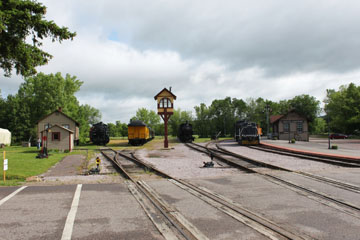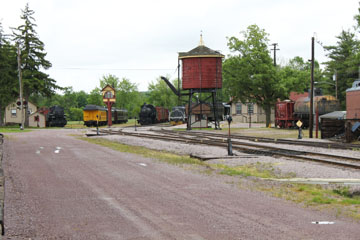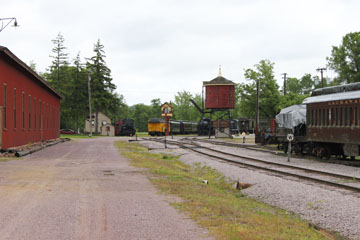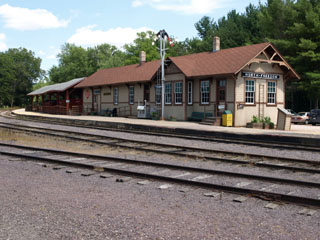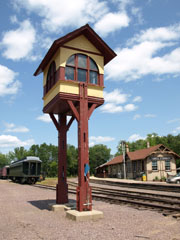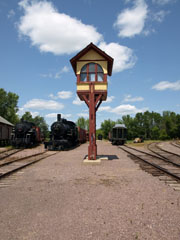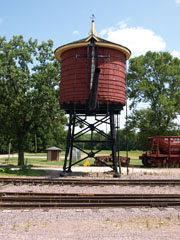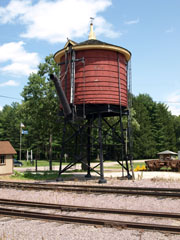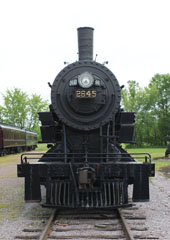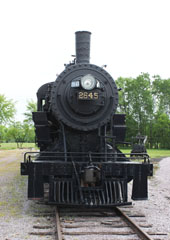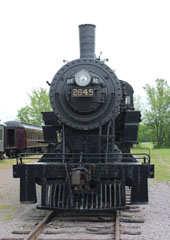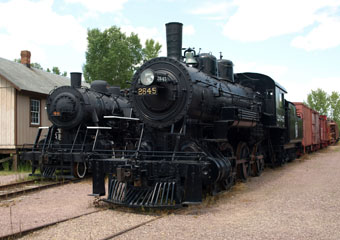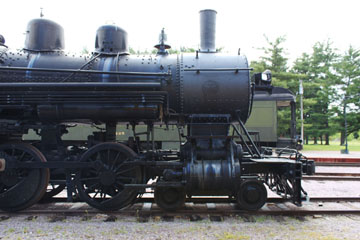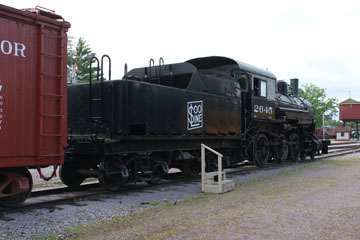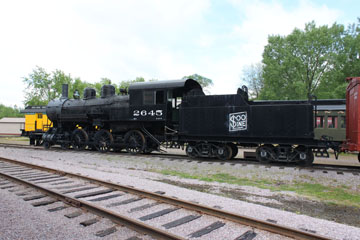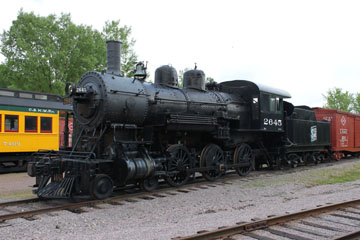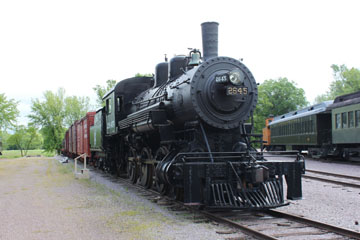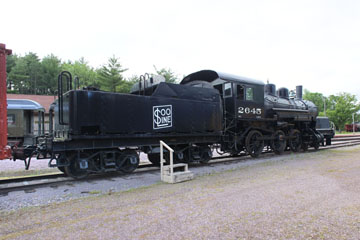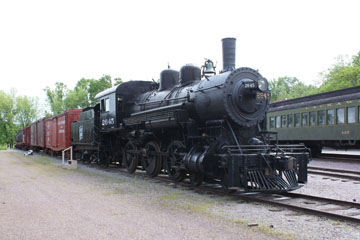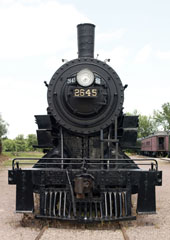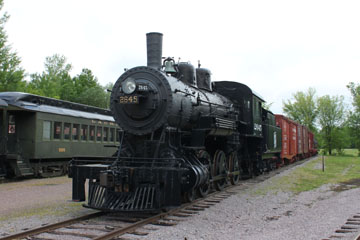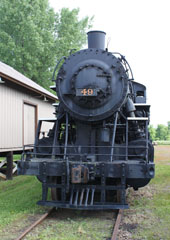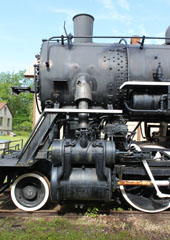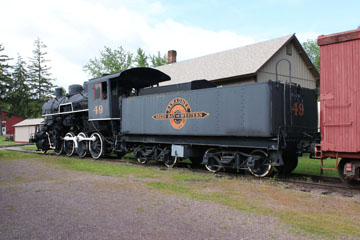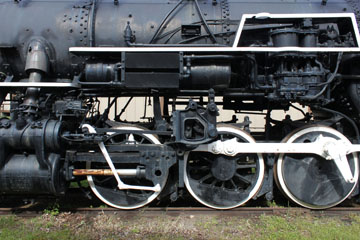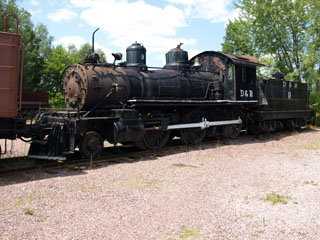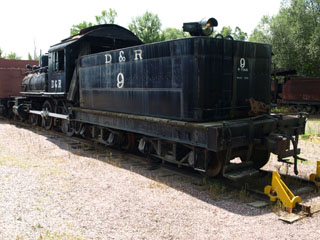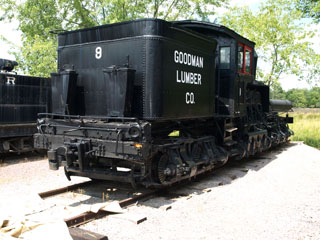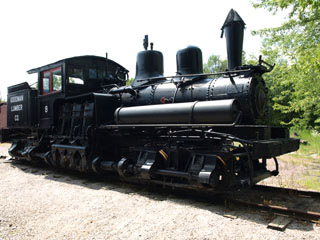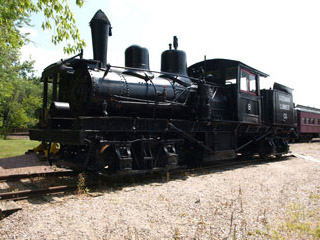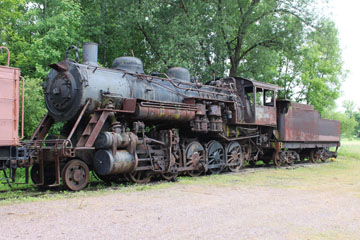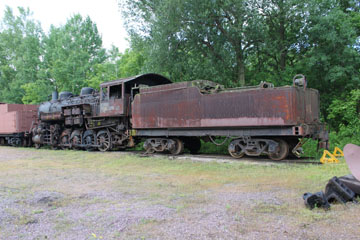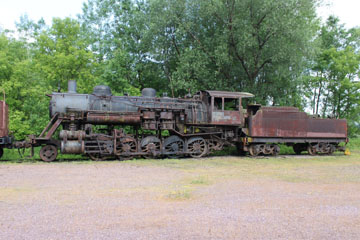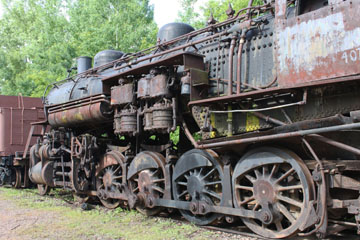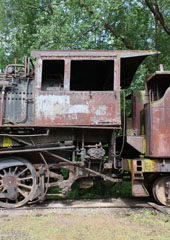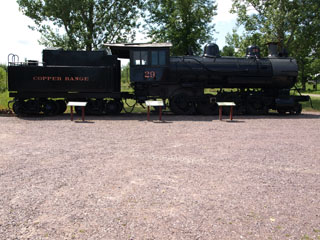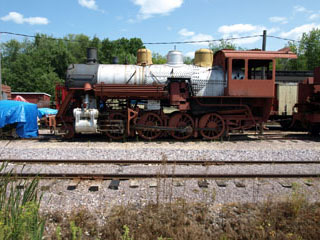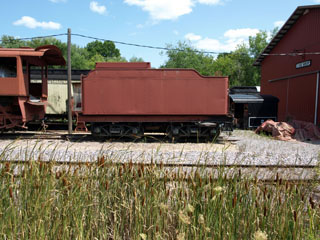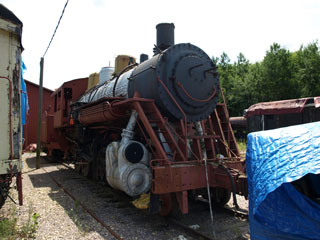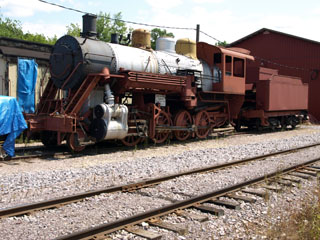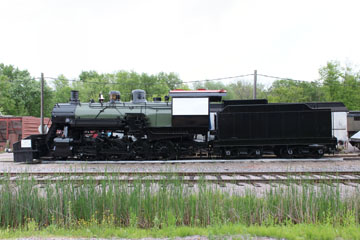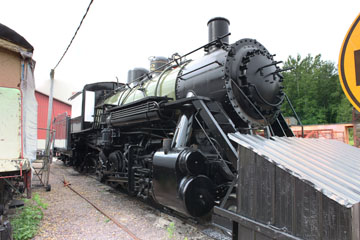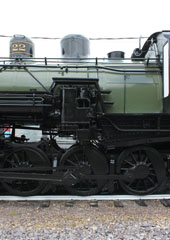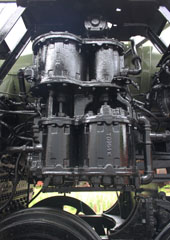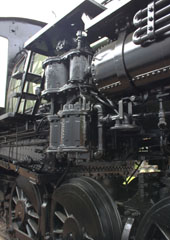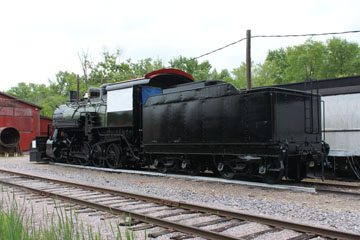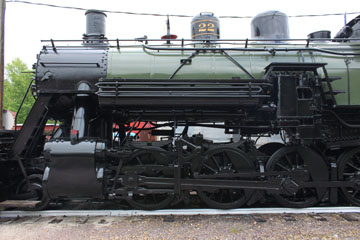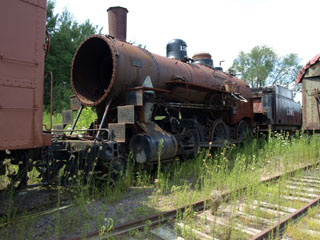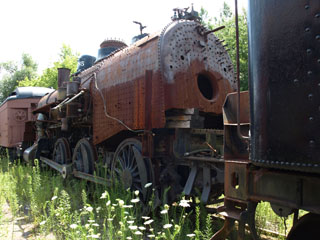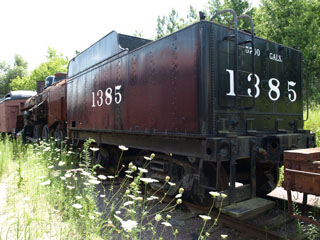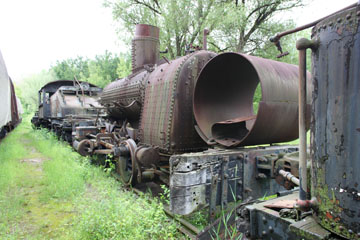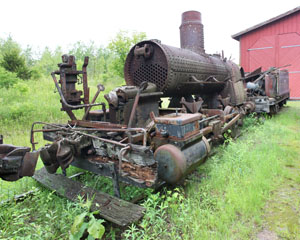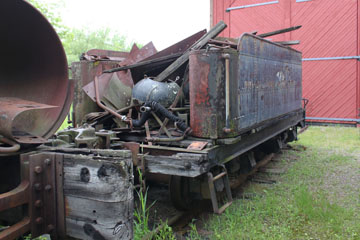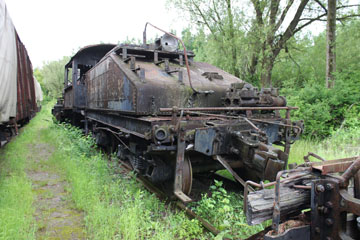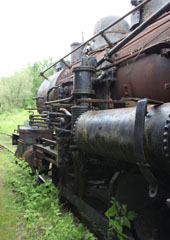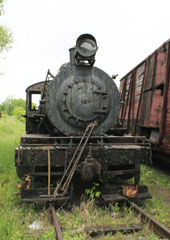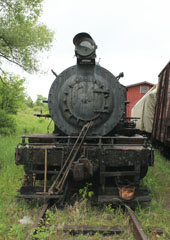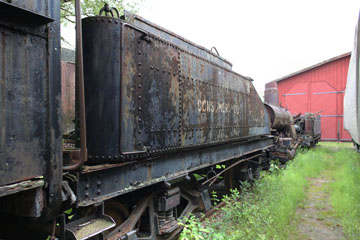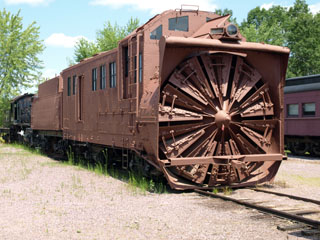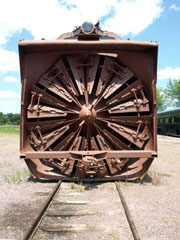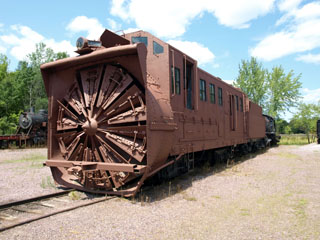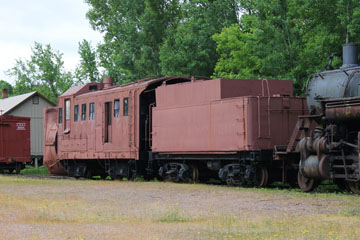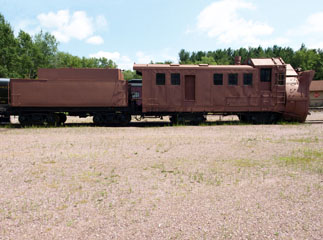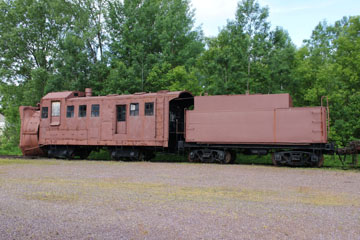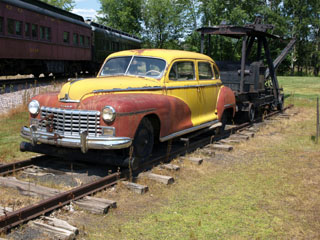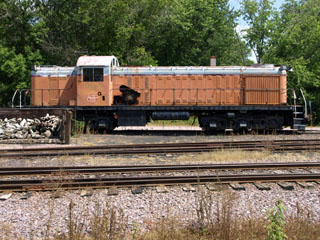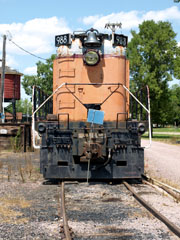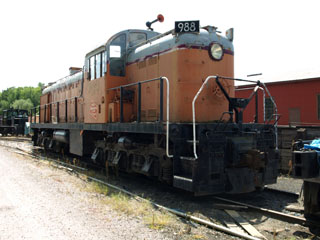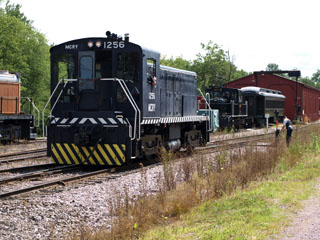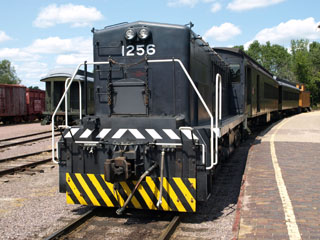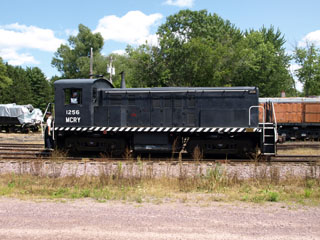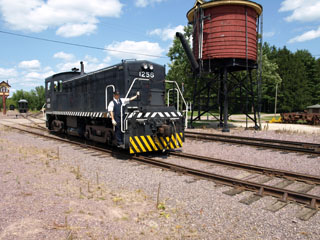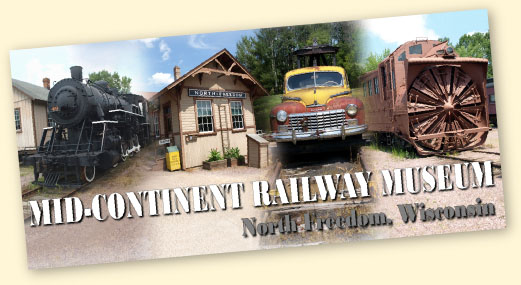

The Mid-Continent Railway Museum is located fourteen miles off the I90/I94 in North Freedom, WI. Its collection comprises fourteen steam and six diesel locomotives, as well as over one hundred other pieces of rolling stock.
The museum began as the Railroad Historical Society of Milwaukee in 1959. Its first locomotive was Consumer Company's 0-4-0 #701 and, in 1962, the locomotive hauled the museum's first excursion on Hillsboro & North Eastern Railway's five miles of line between Union Center and Hillsboro, WI.
In 1963, the society's growing collection moved to what is now its permanent home in North Freedom and began operating excursions on what was originally Chicago & North Western's Rattlesnake Spur, a seven mile line first opened in 1903 to serve the Iroquois and Illinois iron ore mines in La Rue, WI. Abandoned in 1913 after the mines closed, the track returned to use in 1918 when a quarry purchased it. Once again abandoned in 1962, it was a perfect home for the newly renamed Mid-Continent Railway Museum, which bought the line and has owned it ever since. The museum operates excursions on the line from mid-May to Labor Day, currently only with diesel-electric motive power.
#701, the museum's first acquisition, is still in the collection, but was in storage when I visited.

Left and below, the crossing tower at the Mid-Continent Museum was originally located on the Wisconsin Central at Neenah, WI.
It was donated to the museum in 1991. There are plans to install an access stairway, but this had yet to be completed when I visited.
Before automatic crossing control, crossing towers like this were common in larger communities, often near depots or industrial sites where train movements were frequent. From their high vantage point railroad employees could see road and rail traffic and controlled gates manually.
Behind the tower in the photo above is a section
shed once used by the Milwaukee Road in Fond du Lac, WI. It was moved to the museum in 1982, and contains track tools, photos of section crews at work and a 3-wheel velocipede originally used by track inspectors.
The depot building was constructed in 1894 by the Chicago & North Western Railway at Abelmans (today called Rock Springs), WI, about four miles west of North Freedom.
The building was donated to the museum in 1965, moved to North Freedom and restored to its original C&NW paint scheme. Inside, it has two waiting rooms, a ticket office and a freight room on the south end now occupied by a gift shop. There is also a covered freight loading area attached to the north end of the depot building.
Just in front of the water tower in the photo on the left is a crossing shanty.
Where there were no crossing lights, busier railway crossings were often protected by a flagman who stopped road traffic whenever a train was approaching.
Below, another view of the crossing shanty and water tower. Crossing shanties were placed near the tracks so flagmen could relax or shelter from inclement weather between train movements but still keep an eye on road and rail traffic. The museum's crossing shanty came from the Chicago & North Western depot at Lodi, WI, and is still used during special museum events, when a flagman is on duty.
The building centre right below is Coach Shed No.1. It was built by volunteers between 1975 and 1976 and now houses a number of static displays.
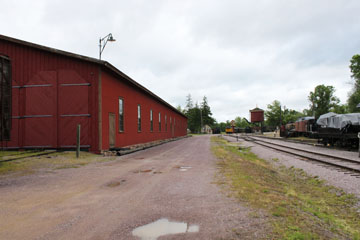

Top view, the Coach Shed on the western side of the yard houses several restored railroad cars, including a GN wooden caboose, an 1888 DSS&A wooden coach, a combination car from Upper Michigan and a Wisconsin Central business car.
Lower view, the Engine House (foreground) and Car Shop (background). The Engine House was built in 1965 to provide a maintenance facility for the museum's fleet of steam locomotives. Designed to resemble a typical shortline enginehouse from the early 20th century, it is a fully equipped machine shop.

This Ten Wheeler (4-6-0) was built in 1900 by the Brooks Locomotive Works in Dunkirk, NY, for the Wisconsin Central as #247.
When the Soo Line leased the Wisconsin Central in 1909, it was renumbered #2645.
Designed to haul freight, #2645 weighs 165,340 lbs, 127,080 lbs on its 57" drivers. has 22" x 26" cylinders and 57" drivers. When superheating was fitted at a later date, extended wagon top boilers replaced the Belpaires and the locomotives were reclassified as E-25-S. The grate area dropped from 54.4 sq ft to 45.3 sq ft, and the firebox from 186.6 sq ft to 165 sq ft.
With a total heating area of 2,160 sq ft, including 370 sq ft superheating, the E-25-S operated at a boiler pressure of 200 psi delivering tractive effort of 31,000 lbs.
The tender weighs 111,200 lbs light and has a 5,000 gallon water and 9½ ton coal capacity.
#2645 spent most of its operating life in Wisconsin on Wisconsin Central's Eau Claire branch, the Portage and Manitowoc lines and switching at locations such as Neenah and North Fond du Lac. In 1955, after accumulating over one million service miles, #2645 was donated by the Soo Line to the City of Waukesha, WI. It went on display at Frame Park in Waukesha until 1972, when it was moved to a railroad-themed restaurant in a former C&NW depot.

#49 was one of four Consolidation (2-8-0) type locomotives built by Alco at its Schenectady, NY, works in 1929 for the Kewaunee Green Bay & Western, a subsidiary of the Green Bay & Western Railroad (the "Green Bay Route") at a cost of
$34,050.
#49 was assigned to haul fast freight between Kewaunee, WI, and Winona, MN, mainly transporting parts for the Ford Motor Company from Detroit to an assembly plant in St. Paul, MN. The train crossed Lake Michigan by car ferry and avoided the congested greater Chicago area.
Special modifications were made to #49 so that it could travel the entire 214 mile trip across Wisconsin. When the Green Bay Route's line was rebuilt in 1936, however, six heavier Mikado (2-8-2) locomotives were purchased to replace the smaller 2-8-0s on the fast freight runs. #49 was renumbered #350 and reassigned to wayfreight and car ferry loading duties.
In 1950, #350 was sold for $9,000 to the Consolidated Water Power and Paper Company, having travelled 1,764,000 miles in twenty-one years on the Green Bay Route system.
#49 was a coal burner. It weighs 174,000 lbs, 156,000 lbs on its 55" drivers, well suited to the lighter 70 lb rails on the KGB&W. The driver wheelbase is 15' 6" and the engine wheelbase is 23' 8". With 21” x 28” cylinders, it has a 43.1 sq ft grate, 161 sq ft firebox and total heating surface of 2,170 sq ft, including 403 sq ft superheating. Operating at a boiler pressure of 200 psi, it delivered tractive effort of 38,200 lbs.
#49 is actually the only steam locomotive to have survived of those that operated on the Green Bay Route.
Consolidated used #350 for switching at their Wisconsin Rapids plant, cutting down the tender sides to improve visibility. The tender weighs 138,000 lbs light and has a capacity of 7,000 gallons of water and 14 tons of coal.
In 1957, Consolidated retired #350 and donated it to the city of Wisconsin Rapids for display display in the municipal zoo. In 1981, Wisconsin Rapids donated the locomotive to the Mid-Continent Railway Museum and, the following year, it received a cosmetic restoration to return it to its pre-1936 appearance and number.

This Mogul type (2-6-0) locomotive was built by Baldwin in 1884 as New Orleans & North Eastern #232.
It received a new wagon-top boiler when rebuilt in 1904 and was sold in 1917 to Birmingham Rail & Locomotive Co., a surplus equipment dealer. They, in turn, sold it to the Dardanelle & Russellville where the locomotive was renumbered #9, serving the Arkansas shortline until 1963, when it was purchased by Elliott Donnelley of North Freedom.
Elliott Donnelley donated #9 to the museum in 1969, and it was the main duty engine at the museum in the 1960s and 1970s until it was sidelined because of a leaking tender. It returned to service in 1991 for one summer with a temporary tender but, since then, has not steamed.
#9 is the oldest locomotive in the museum's collection. It weighs 130,000 lbs, and has
19” x 24” cylinders and 51” drivers. Operating at a boiler pressure of 180 psi, it delivered 26,000 lbs tractive effort.

#9 was one of three Shays built in 1909 for the Sawyer-Goodman Lumber Company of Marinette, WI. #9 went to Goodman, WI, where a new mill had just been completed.
The other two went to Marinette.
A 3-truck Shay, #9 weighs 72,000 lbs, and has 28” drivers and 10” x 10” cylinders. Operating at a boiler pressure of 200 psi, it delivered tractive effort of 14,320 lbs.
In their heyday, over one hundred Shays worked in the forests of Wisconsin, but #9 is the only survivor. You can see other 3-truck Shays on the Cass Scenic Railroad page of this website, the Travel Town page, Northwestern Railroad Museum page and
the B&O railroad Museum Roundhouse
page.
#9 worked on the Goodman Lumber Company's private logging railroad until the main line to the mill (served by the Soo Line) was abandoned in 1939. After the line to the mill was abandoned, #9 switched cars at the mill until it was replaced by a Whitcomb diesel locomotive.
In August 1955, the Goodman family sold the mill and #9 was donated to Historyland Museum at Hayward, WI. After Historyland went bankrupt, Mid-Continent purchased #9 in 1988 and moved it to North Freedom.

Equipped with Walschaert valve gear, 24" x 28" cylinders, a 54.3 sq ft grate, 197 sq ft firebox and total heating surface of 2,896 sq ft, including 553
sq ft superheating, #401 operated at a boiler pressure of 190 psi delivering 46,512 lbs tractive effort. The tender weighs 141,500 lbs light and has a capacity of 12 tons of coal and 7,000 gallons of water.
After twenty years of service, #401 was sold by the Alabama, Tennessee & Northern to the used equipment dealer the Birmingham Rail & Locomotive Company in Alabama in 1948.
The Baldwin Locomotive Works built this
Decapod type locomotive (2-10-0) for the
Alabama, Tennessee & Northern Railroad as #401 in 1928. It was one of two delivered that year (#401 and #402) and a third was delivered the following year (#403). Designed to produce a relatively high tractive effort with a light axle loading on the AT&N's 63 lb rails, all three locomotives were designated Class 401.
With an engine wheelbase of 28' 3" and driver wheelbase of 19' 8", #401 weighs 212,000 lbs, 190,000 lbs on its 56" drivers.

#29 is one of eight Consolidation type (2-8-0) C2 class locomotives built by Alco in 1907 for the Copper Range Railroad in upper western Michigan.
The railroad eventually rostered twenty-four steam locomotives.
By 1953, the other Consolidations had been scrapped and #29 was the last Copper Range steam locomotive left. In 1967, it was sold to the Keweenaw Central Railroad, a tourist operation and used on their passenger excursions between Calumet and Lake Linden, MI.
Unfortunately, after only three years in service, boiler problems sidelined the locomotive in 1970. Abandonment of the Copper Range Railroad in 1972 then forced Keweenaw Central to cease operations.
#29 weighs 170,000 lbs, and has 50” drivers and 22” x 26” cylinders. Operating at a boiler pressure of 180 psi it delivered tractive effort of 38,510 lbs.
#29 hauled both freight and passenger trains until 1946 when passenger services were discontinued. That year, the Copper Range ordered two 1,000 hp diesel locomotives from Baldwin and, after they arrived the following year, scrapped half its remaining fleet of steam locomotives, leaving #29 and three other Consolidations.
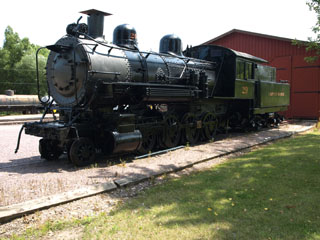

#29 sat outside the ruins of the Quincy smelter in Hancock, MI, exposed to the elements from 1973 until it was finally offered to the Mid-Continent Museum in 2004 with the proviso that the locomotive was moved by Summer that year.
$20,000 was soon raised to pay for the
move and the locomotive left the Copper Range for the last time on 26th May 2004.
It was unloaded at the museum the
following day and has now been
cosmetically restored.

Above, below and right, when I first visited the museum, restoration work had just begun on LSI SC4 #22.
This Consolidation type (2-8-0) locomotive was built at Alco's Pittsburgh, PA, works as #38 in 1910 for the Marquette & Southeastern, which operated a sixty mile line between Big Bay and Lawson, MI. One year later, the M&SE became the Munising, Marquette & Southeastern. In 1923, when the MM&SE merged with the Lake Superior & Ishpeming, #38 was renumbered #22.
#22 was one of twelve LS&I Consolidations sold to the Marquette & Huron Mountain Railroad tourist line in 1963. The Marquette & Huron operated on the recently abandoned LSI Big Bay branch line.
#22 steamed on the Marquette & Huron from 1964 to 1965.
Modernised with a wider firebox in 1931, #22 weighs 189,360 lbs, has 57" drivers, 22" x 28" cylinders, a 50 sq ft grate and total heating surface of 2,600 sq ft, including 430 sq ft superheating, Operating at a boiler pressure of 200 psi, it delivered 42,000 lbs tractive effort.
The LS&I was one the last Class I railroads to dieselise in the US, and #22 worked for over fifty years based at Marquette, MI, where ore was delivered to a dock for loading into Great Lakes ships.
Above, last time I visited, work on #22 had progressed significantly. Only some final work was pending on the boiler tubes to meet FRA requirements.
#22's last run on the Marquette & Huron was on Labor Day 1965. In 1985, the tourist line ceased operations and its equipment was put up for sale, at which time #22 was bought by the Mid-
Continent museum. Four LS&I SC-4s have survived. You can see #24 on the National Railroad Museum page of this website, and #19 is on the LSI #19 page.

Designed for fast freight, the R-1s were
also used for secondary passenger trains
and local switching across the C&NW system.
#1385 was bought by the Historical Society of Milwaukee in 1961 for $2,600 and was in service for most of the 1980s and 1990s on excursion services. It is one of only eight C&NW preserved locomotives that have been preserved. You can see another R-1 and find out more about these engines on the CNW #175 page of this website.
This Ten Wheeler (4-6-0) locomotive was
built in 1907 at Alco's Schenectady, NY, works.
Between 1901 and 1908, three hundred and twenty-five of these R-1 class locomotives were built for the C&NW, making them the largest single class of locomotive the railroad ever owned. They had a pivotal role in the railroad's development, requiring the rebuilding of tracks, bridges, turntables and engine houses to accommodate their added size.
The tender coupled to #1385 was originally mated with CNW R-1 #1361 built by Alco in 1906. #1361 was an oil burner, assigned to C&NW's western lines but was scrapped in September 1944. However, the tender survived and was last used as an auxiliary for CNW steam pile driver #X263579 at Proviso Yard, WI.
In the early 1970s, as the museum began restoring #1385, its original tender was considered beyond repair, so #X263579's tender was bought for use with #1385.

In 1936, the Ponchatoula mill reopened as the Louisiana Cypress Lumber Company and the 2-6-0 returned as #2, working as backup to the road locomotive #1, a 2-6-2 built by Porter in 1921, and as a switcher at the mill.
A coal burner, #2 weighs 59,600 lbs,
50,400 lbs on its 35” drivers. With
14” x 18” cylinders, it operated at a boiler pressure of 150 psi, delivering 13,330 lbs tractive effort. It is the oldest known Lima rod locomotive in existence.
This Mogul type (2-6-0) was built by the Lima Locomotive Works in 1906 for the Ellisville Lumber Company in Ellisville, MS, where it was numbered #1027, its Lima construction number. The Ellisville mill burned down in 1908 and the company went into receivership.
The nearby Kola Lumber Company bought the Ellisville interests, including #1027 in 1912. In the early 1920s, the engine was sold to the Williams Lumber Company at Ponchatoula, LA, and then, in 1921 to the Joseph Rathborne Lumber Company near New Orleans, LA. Rathbone closed in 1929.
In 1960, #2 was bought by the museum and went into storage in Milwaukee until the museum found a permanent home in North Freedom, arriving there in 1964, where it was put into operation.
By the early 1970s, #2 was out of service and on static display. An aborted effort was begun to restore the engine to service and parts were shipped to a machine shop in Milwaukee, but the work was never completed and the parts were returned to North Freedom in the 1990s.

#701 was built at Alco’s Schenectady, NY, works in 1914 for the Chicago & Illinois Western, a shortline switching railroad incorporated in 1903 running ten miles from Chicago to Gary, IL, with a two mile branch line to Hawthorne, IL The line was later absorbed into the Illinois Central.
At some point, #701 was sold to the Dolee & Shepard Company in Hodgkins, IL, and then to the Consumers Company in South Beloit, IL. When the Consumers Company merged with the Vulcan Materials Company in 1959, it was donated to the Railway Historical Society of Milwaukee.
The Railway Historical Society of Milwaukee later became the Mid-Continent Railway Historical Society, and #701 was the first steam locomotive in the Mid-Continent’s collection. It was initially moved to Hillsboro, WI, in 1962 along with CNW #1385 and was finally moved to North Freedom in 1963 when the museum acquired the property there.
A coal burning 0-4-0, #701 weighs 110,000 lbs. It has 44” drivers and 18” x 24” cylinders. Operating at a boiler pressure of 170 psi, it delivered 25,535 lbs tractive effort.

#762 is an oil fired, steam operated rotary snow plow built by Alco for the Oregon Short Line, a subsidiary of the Union Pacific, in 1912. #762’s original body was wood, but at some time the UP replaced this with riveted steel plates.
The large rotating blade at the front of the plow operated by the plow's engine threw snow out by centrifugal force through a directional chute above the blade, but the plow must be pushed through the snow by another locomotive.
In 1936, #762 was renumbered UP #051 and then, some time later, UP #900051. In 1971, it was retired and moved to a restaurant at Blackfoot, ID. In 1980, it was donated to the museum. The museum restored #762 to operating condition, although repairs to the boiler are currently required before it can operate again.
The tender from the museum's steam wrecker MP #X-105 was mated with the rotary as it more closely resembled the type it would have had when first built.

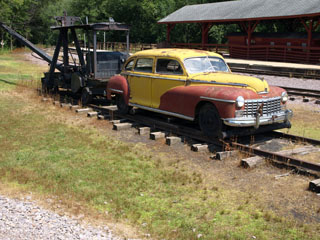
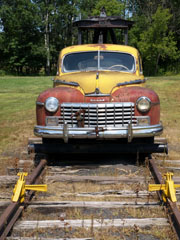
This 1947 Dodge 4-door sedan equipped with special wheels carried Milwaukee Road officials along the railroad, and is actually an early version of the "highrail" pickup truck, widely used by US railroads. Retired in 1961, it was purchased in 1962 by the museum for its first season in Hillsboro, WI.
#30 moved to North Freedom in 1963 with the rest of the collection and,
in the 1970s, was restored to Milwaukee Road's orange and maroon
livery by the Seabees. Behind #30 you can see Western Pacific Burro Crane #B-63 built by Cullen-Friestedt of Chicago, IL, in 1927. This convenient light duty crane is powered by a 4-cylinder Buda diesel engine and was used to move ties, rail and other material. It was donated to museum in 1973.
Cullen-Friestedt was formed in 1907 to manufacture lifting and handling equipment and is still in business today as a division of Badger Equipment Company. You can see other Burro cranes on the Southeastern Railroad Museum, Gold Coast Railroad Museum and Savannah Roundhouse Railroad Museum pages of this website.

#988 was built by Alco
in 1947. It is one of twenty-two RSC-2s delivered to the Milwaukee Road.
Eighty-one RSC-2s were built by Alco between 1946 and 1947, all but twelve for US railroads (the additional twelve went to Caminhos de Ferro Portugueses).
#988 was part of that experiment and, soon after, was transferred to the railroad's Iowa & Dakota Division. There, in 1959, it was re-numbered #594. In the early 1960s, it was subsequently assigned to La Crosse, WI.
By the early 1970s, most older Alco engines had
been scrapped but, as late as June 1976, #594 was still switching at La Crosse. It escaped the scrappers
when it was bought by the Kettle Morain Scenic Railway in 1976 and renumbered #4. Then sold
to Trans-Northern Inc., it was renumbered #988.
TN used #988 on several of their shortline operations until early 1981 when the locomotive was shut down and placed in storage on the Escanaba & Lake
Superior.
Finally, in 1985, a group of Mid-Continent members got together to purchase #988 from TN, and the locomotive arrived at North Freedom in January 1986. It has since been returned to its original 1947 orange and black Milwaukee Road paint scheme.



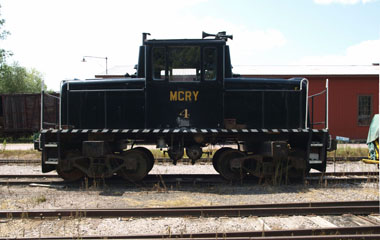
#4 was built in 1943 by General Electric for the US Navy. It is powered by two Cummins NH150 diesel engines developing a total of 300 hp. Each engine powers a generator which, in turn, powers a motor on each truck with side rods connecting the axles.
The scrap dealer Precision Engineering bought #4 from the Navy at an unknown date and the locomotive was subsequently sold to car builder Pullman-Standard who donated it to the museum in 1972. It is currently used by the museum as a switcher, moving dead engines in and out of the shop, as well as cars in the yard.


GE's 45 ton switcher was extremely versatile, with a high weight to power ratio and excellent traction. They were built with a short wheelbase for industrial plants, yards and places where clearances were tight and, although intended as switchers, they sometimes performed mainline duties.
You can see other GE switchers on the B&O Museum Yard & Car Shop, Savannah Roundhouse Railroad Museum, National Railroad Museum and Lake Superior Railroad Museum pages of this website.



Mid-Continent Railway #1256 hauled the passenger excursion when I visited. The consist included DMIR #C-74, a standard cupola caboose built in 1924 by the Duluth, Missabe & Northern. Absorbed into the DM&IR in 1937, #C-74 has been maintained in its 1965 appearance.
Also in the consist were Delaware Lackawanna & Western coaches #557 and #25, built by the Pullman Company between 1914 and 1917 for suburban passenger service in New York and New Jersey.
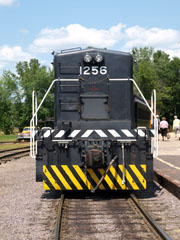
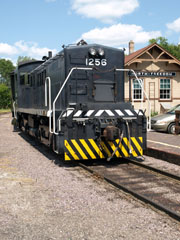
#1256 is one of seventy-four RS-4-TC switchers built by Baldwin from 1953 to 1955 for the US Army and Air Force. Originally ordered from Whitcomb, a subsidiary of Baldwin since 1931, they were constructed at Baldwin's Eddystone works as Whitcomb's production had transferred there from Richelle, IL, in 1951. They were powered by a 400 hp Caterpillar D397 12 cylinder diesel engine connected to Westinghouse electric transmissions.
#1256 was delivered to Sharpe Ammo Depot in Lathrop, CA, and placed in storage. Later used at Detroit Tank Plant, it was rebuilt by Construction & Mining Services' TEAD Annex in 1986. The rebuild incorporated a 500 hp Caterpillar 3508 diesel engine, new electrical gear and roller bearing axles. The new RS–4-TC–A1 class locomotive worked at Hill Air Force Base in Utah until transferred to Badger Army Ammunition Plant near Baraboo, WI, some time between 1991 and 1994.
In 2006, the Army decided to dispose of #1256 and allowed it to be shipped to the Mid-Continent Museum until its final disposition was known. It arrived on 14th September 2006 and, the following month, was purchased by members and friends of the museum at auction and donated to the museum.





